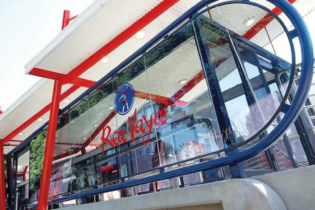It is not every day that a truck is custom-built and tested to near-destruction to ensure that it is tough enough to handle African conditions. No surprise then that the Axor is such a popular choice among operators in the region.
The Axor was designed and manufactured by Mercedes-Benz to fill the gap between the premium Actros tractors and the mostly rigid Atego trucks. It was first introduced in South Africa in 2003 and has since recorded sales of more than 9 000 units, with the 3340S/33 model proving to be one of the most popular. “The Axor was originally developed for agricultural purposes in Brazil and later customised for the African market in terms of fuel compatibility, carrying capacity, suspension, axle mass, cab design and model range. This truck represents a successful global collaboration between Daimler AG in Germany, the development centres in Brazil and Turkey, and our local engineers in East London,” says Christo Kleynhans, product manager at Mercedes-Benz Trucks. To ensure that the Axor is tough enough for Africa, test rigs are subjected to conditions several times more extreme than they will ever encounter on the road. “Axor engines have to survive temperature, partial-load, full-load and endurance tests equivalent to some 3.6 million kilometres of driving. For the cab, the simulated crash test results are confirmed in real-life pendulum impact tests on the front end, roof-load and rear-panel pressure tests. Even the seats have to be able to withstand extremely high G-forces without being torn from their mountings during a crash,” Kleynhans continues. Going the extra mile, cleanly and cost-effectively With 15 truck tractor and freight carrier models in the Axor stable, the range offers versatility to African operators and is currently used in many industries, ranging from agriculture, construction and building, timber and mining, to professional haulage. Kleynhans adds that the Axor’s robust design is another ‘plus’ for the African market. The truck delivers impressive performance in terms of reliability and longevity, displaying an extraordinary ability to clock up the miles. “The Axor has been designed to ensure that repairs can be carried out as quickly as possible, so it spends less time in the workshop and more on the road. Additional benefits are the long service life of all major components and operating fluids that do not need changing during the vehicle lifetime. A range of parts, such as the rubber molecular bearings, are now also completely maintenance-free,” he says. With its durable, economical and powerful six-cylinder engine and special powertrain configuration, the Axor is regarded as very efficient truck. Add to this the Telligent engine management system, and you have a vehicle that maintains power, while using less fuel and reducing the amount of nitrogen oxide and particulate emissions. “It constantly calculates the correct injection timing, the optimal injection metering and the precise injection period for a current driving situation at lightning speed, based on the continuous input of relevant data such as air and boost pressure as well as engine, fuel and charge air temperature. Outstanding efficiency is assured thanks to pump-line-nozzle technology, the five- or six-hole injection nozzles and an extremely high injection pressure of up to 1 800 bar,” says Kleynhans.Less weight, more payload
A host of measures have been implemented on the Axor 4×2 truck tractors to reduce the weight wherever possible and achieve the perfect balance between robust design and high payload. Vehicle weight has been reduced through, among others, the new direct-drive transmission, the two-bellows air suspension and the front-spoiler bumpers, which are made from weight-saving plastic. No compromise on safety Safety features are designed to protect both the driver and the vehicle. In addition to offering comfortable custom-designed cabs for long-distance and distribution applications, the cab is constructed to offer maximum protection. For instance, only flame-retardant, splinter-proof materials with rounded corners and edges are used in the interior and seatbelt tensioners come as standard. Visibility is enhanced through clear-glass headlamps that illuminate a wide area of the road, heated exterior mirrors and wide-angle rear-view mirrors mounted below the main mirrors. The curved design of the mirror glass and the new front bumper view mirrors further reduce blind spots. At the heart of the Axor’s safety lies an extremely powerful brake system fitted as standard. Certain models with an output of 260 kW/354 hp are fitted with the Turbobrake, which improves braking considerably when driving down steep hills. The Axor fitted with a 295 kW/401 hp engine comes standard with a Voith retarder instead of a Turbobrake. Axor 2628/45 used for road rehabilitation– make this paragraph stand out On 20 July 2012, Mercedes Benz-Benz South Africa delivered a fleet of five Axor 2628/45 trucks to Velocity Road Rehabilitation South Africa, a subsidiary of Mvelaserve. The trucks have a very sophisticated application designed to fix potholes on the country’s roads. The Velocity will be introduced in Gauteng, Mpumalanga, the North West and the Free State, with plans to expand to the rest of the country and into Africa. “When we made the comparisons, we unanimously agreed on a Mercedes-Benz truck. Because of our plans to expand the company into neighbouring countries, the overriding factor that we considered was the support available from Mercedes-Benz,” said Frank Cattich, MD of Velocity SA. “The Axor is a comprehensible choice for Velocity SA’s requirements, with its all-round features, including robust design and long service intervals,” says Cornel Oelofse, general manager of new commercial vehicle sales at John William’s Commercial Vehicles Bloemfontein. “The Axor qualifies as the best-fit transport solution for the Velocity road repair machine – a fully, self-contained unit that’s used to repair potholes and road surface defects instantly and effectively.” The trucks have been fitted with high-velocity technology that will change the face of road maintenance in Southern Africa. The cutting-edge technology, which has been developed since 1985 and implemented over nearly two decades in various countries – including the UK with its severe winters and wet conditions – has proven its worth as the fast, economic alternative to conventional road patching.






